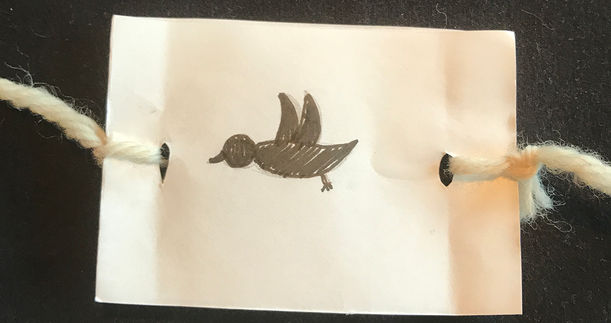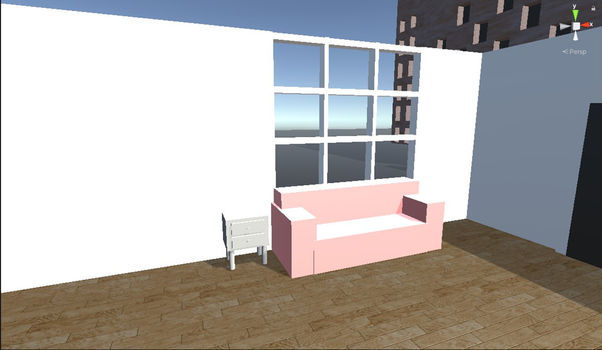Week One
Raiding the Pantry
12 x 5 Minutes
Testing 3D form using paper and black lines. I folded and scrunched the paper to create depth, then lined the folds to show a clearer difference between the flat space and modified space.
Paper and pencil sketches. Focused on sketching ideas around what I could use as a reference for future trials and the 2D aspect of my project.
Attempted to create spinners. Using paper and string, drew shapes on each side that were slightly altered so when spun a moving or '3D' image was created. The video below shows the circle spinner being used and the effect that is created with a full circle on one side and a squished circle on the other.
12 x 10 Minutes
Wanted to create simple ideas around how combining the 2D and 3D form. Cutting paper around the edges from the outside to the centre. When together and laid flat it is kept as a 2D piece, when the centre is pulled up the 3D effect is created.
Using paper to create a pop-up or cut out piece. The first attempt was to create a chair form and used the black lines to accentuate the object more clearly. The second attempt did not work as well as planned, I wanted to create a regular square that I could then draw a 2D piece on. It worked to an extent but it is not as clean and clear as I was hoping.
As I am working with 2D in a very simple way and my main colour scheme is black and white, I wanted to trial a more inverted view of my 2D work. So far my 2D work has been using white space and black lines, I thought to use a white wax crayon and black watercolour to create an opposite perspective.
My last 10-minute trial was looking at using the 2d form with the real world 3d form. To do this I sketched out quick landscapes with negative space which I could then cut out. And after lining them in black pen to resemble the aesthetic I have been going for so far I then proceeded to take photos around the house with different backgrounds for the cutout pieces.
12 x 15 Minutes
The previous 10-minute work I did was the catalyst for the first of my 15-minute trials. I wanted to trial looking at using 2D imagery within a 3D world again but this time using all digital mediums. The photos I used were previously taken by me and I used photoshop to draw over parts of the photo continuing with the white and black colour scheme.
Using Maya (A modelling software) I wanted to test my skills and modelling pieces of furniture that I could expand on in the future for my full game. I modelled a small drawer, lamp and fridge. I wanted to keep the shapes basic so that I could understand the base construction that would be needed when I model more detailed objects later on.
The last of my 15-minute trials were centred around the 2D aspect of my project. Using photoshop I created 3 digital drawings that included furniture so I could plan the layout I may use in my project. I will be using these drawings in my 30-minute trials as well as examples of how I may possibly set up my final game
12 x 30 Minutes
Following similar ideas that I looked at in a lot of my first dozen of trials, I wanted to look at creating the 3d form using something that is 2d. For this trial, I created a series of paper theatres of shadow boxes. I started off with the sketch of the 3 pieces needed with the background, middle and foreground. I then cut them out, lined them up and used either paper or foam pieces to stick them together to create a 3D perspective. This perspective I find interesting and may be something that I could use in my game. The first trial I created using a tree, swing and bushes. I then decided to keep it a bit simpler and used various shapes for the second trial and different line tpes for the third.
Using the digital drawings from a previous trial, I then wanted to experiment with how they would look in Unity in a test game space. The test game space uses my basic white and black look while being a 3d space, then using planes and Unity I was able to place my drawings on the flat walls of the rooms.
As my focus so far had been on a more physical medium which was paper, I wanted to start using the time constraints to explore more of my project. Using basic shapes and the 3d objects I had trialled earlier I started to look at the possible setups of the rooms. I planned to have more than two but due to running out of time for all of the trials, I had to pause on this and work on other trials. Having the ability to start viewing placement and layout is really helpful.
3 x 1 Hour

As one of the last trials that I had time for I started to recreate a room that I had already created in unity but changed it so that it reflected more of the 2d version. recreating the room is part of my idea of 'switching' the rooms between the 2d and 3d version around the player. both rooms will look exactly the same however due to the nature of the way I have designed the 2d space, the perspective will be different.
Week One Reflection
In week one, I had trouble initially deciding how much work I would make physically and how much would be digital. Due to the time constraints, I ended up with the decision of making the majority physically. I tried to keep it simple but using paper to create my works, focusing on cutting them and folding them to create my different ideas. When it came to the digital aspect, I wanted to create pieces that took ideas from the first set of works and expand them in a digital setting. For these processes, I used Photoshop, Maya and Unity. I wanted to work with mediums that I was familiar with as I was aiming to test out various ideas that I could then use in the further weeks and my main project. From here, I plan to start working more digitally in the following weeks with this assignment.
Week One Feedback
This week we were tasked with choosing three words from a list that would describe how we were planning to make artefacts. Out of the list, I decided on the words solid, standardised and processed. I chose these three words as I felt that since I was working with predominately paper to be seen as a sequence and keeping the imagery relatively flat and geometric, they would work the best.
Feedback for this week in class was for everyone to try and guess the three words we chose by looking at the artefacts we made. Down below is all the responses.
Processed
Ephemeral
Porous
Sticky
Solid
Processed
Ready-made
Ephemeral
Sticky
Solid
Standardised
Processed
Porous
Standardised
Raw
Desiccated
Sticky
Solid
Raw
Processed
Porous
Cold
Raw
Porous
Solid
Processed
Cold
Standardised
Processed
Solid
Processed
Standardised
Solid
Raw
Solid
Porous
I find it interesting to see the words that others chose when they looked at my work, as for the most part, I didn't initially see how they could fit. I still struggle to see how certain words fit within my artefacts but understanding that this is how others have viewed my works gives me new perspectives to think about. Three people guessed all three out of all the guesses, which I found surprising as I felt my chosen words might have come off as obvious.
Week One In Class Work
1. Do you place limits on the scope of your creative practice through the conscious (or unconscious) application of constraints? For example, do you repeatedly use similar conceptual, formal and technical approaches to address creative problems/design briefs? What are these approaches? Write them down.
Unsure, I do tend to follow the same approaches -> bullet pointing ideas, concept sketches, prototyping, youtube tutorials
2. What methods do you currently employ in your practice? Write them down and identify how you currently use these methods in your practice.
The iterative process is my main method, mostly prototyping my creations before testing which is repeated over and over
3. Do you limit the methods that you use for fear new methods will not work, thereby mitigating (reducing) risk? Why do you do this? Identify and write down a range of new methods you would like to trial.
50/50. I begin with working with ideas/concepts/prototypes that I know will work. Using youtube tutorials, always trying to find new things to add whether it will work or not.
4. How do you currently ‘make do’ with constraints related to accessing time, space, money and materials to make work? What strategies have you developed to manage this complex matrix of constraints shaping creative practice?
I take what time I can get and work with what I have. Some programs require education licenses which I can only get from uni, I use them while I can.















































































